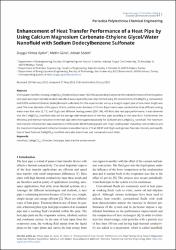| dc.contributor.author | Yılmaz Aydın, Duygu | |
| dc.contributor.author | Gürü, Metin | |
| dc.contributor.author | Sözen, Adnan | |
| dc.date.accessioned | 2022-07-26T05:56:52Z | |
| dc.date.available | 2022-07-26T05:56:52Z | |
| dc.date.issued | 2022 | en_US |
| dc.identifier.citation | Yılmaz Aydın, D., Gürü, M., Sözen, A. (2022). "Enhancement of Heat Transfer Performance of a Heat Pipe by Using Calcium Magnesium Carbonate-Ethylene Glycol/Water Nanofluid with Sodium Dodecylbenzene Sulfonate", Periodica Polytechnica Chemical Engineering, 1-8 | en_US |
| dc.identifier.issn | 0324-5853 | en_US |
| dc.identifier.issn | 1587-3765 | en_US |
| dc.identifier.uri | https://doi.org/10.3311/PPch.20040 | |
| dc.identifier.uri | https://hdl.handle.net/20.500.12899/1180 | |
| dc.description | Early Access | en_US |
| dc.description | Received: 20 February 2022, Accepted: 27 May 2022, Published online: 05 July 2022. | en_US |
| dc.description | Duygu Yılmaz Aydın, Department of Bioengineering, Faculty of Engineering and Natural Sciences, Malatya Turgut Ozal University, 70 Alacakapı St, 44210 Malatya, Turkey.
Metin Gürü2, Department of Chemical Engineering, Faculty of Engineering, Gazi University, 5 Yükselis St, 06570 Ankara, Turkey.
Adnan Sözen, Department of Energy Systems Engineering, Faculty of Technology, Gazi University, 6/22 Bandırma St, 06560 Ankara, Turkey. | en_US |
| dc.description.abstract | In this paper, the effect of using CaMg(CO3)2/Ethylene Glycol-water (50:50%) as a working fluid on the thermal performance of thermosyphon heat pipe was experimentally studied. Nanofluid was prepared by two-step method using 2% concentration of CaMg(CO3)2 nanoparticle and 0.05% surfactant (Sodium dodecylbenzene sulfonate). For the experimental set-up, a straight copper pipe of one-meter length was used. The inner diameter of the pipe is 13 mm, and the outer diameter is 15 mm. Experiments were conducted at three different cooling water mass flow rates (5, 7.5, and 10 g/s) and different heating powers (200, 300, 400 W) to test heat pipe performance. It was observed that the CaMg(CO3)2 nanofluid reduced the average wall temperature of the heat pipe according to the base fluid. Furthermore, the efficiency and thermal resistance of the heat pipe were investigated separately for EG/water and CaMg(CO3)2 nanofluid. The maximum heat transfer enhancement was obtained as 9.55% under 400 W heating power and 10 g/s cooling water mass flow rate conditions and the maximum improvement in thermal resistance was observed as 21% at 200 W and 10 g/s cooling mass flow rate. Viscosity and specific heat of base fluid and CaMg(CO3)2 nanofluid were also determined and compared to each other. | en_US |
| dc.language.iso | en | en_US |
| dc.publisher | Budapest University of Technology and Economics | en_US |
| dc.relation.ispartof | Periodica Polytechnica Chemical Engineering | en_US |
| dc.rights | info:eu-repo/semantics/openAccess | en_US |
| dc.subject | Nanofluid | en_US |
| dc.subject | CaMg(CO3)2 | en_US |
| dc.subject | EG/water | en_US |
| dc.subject | Heat pipe | en_US |
| dc.subject | Heat transfer enhancement | en_US |
| dc.title | Enhancement of Heat Transfer Performance of a Heat Pipe by Using Calcium Magnesium Carbonate-Ethylene Glycol/Water Nanofluid with Sodium Dodecylbenzene Sulfonate | en_US |
| dc.type | Article | en_US |
| dc.authorid | 0000-0003-0557-5279 | en_US |
| dc.department | MTÖ Üniversitesi, Mühendislik ve Doğa Bilimleri Fakültesi, Biyomühendislik Bölümü | en_US |
| dc.institutionauthor | Yılmaz Aydın, Duygu Duygu | |
| dc.identifier.doi | 10.3311/PPch.20040 | |
| dc.identifier.startpage | 1 | en_US |
| dc.identifier.endpage | 8 | en_US |
| dc.relation.publicationcategory | Makale - Uluslararası Hakemli Dergi - Kurum Öğretim Elemanı | en_US |
| dc.identifier.scopus | 2-s2.0-85139386630 | en_US |
| dc.identifier.scopusquality | Q3 | en_US |
| dc.identifier.wos | WOS:000823674100001 | en_US |
| dc.identifier.wosquality | Q4 | en_US |
| dc.indekslendigikaynak | Web of Science | en_US |
| dc.indekslendigikaynak | Scopus | en_US |


















